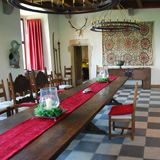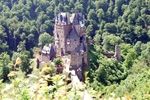History
Burg Pyrmont was built in the late 12th century by Cuno of Schönburg on a slate rock outcrop above a rushing waterfall on the River Elzbach in the Eifel Mountains of Germany. It first appeared in written history in 1225.

In 1441, Cuno VI of Pyrmont specified in his will how his inheritance was to be split among his three quarrelsome sons to protect the ancestral seat of the family dynasty, but this did not prevent the squabblers from fighting over the castle after his death. His son Henry had the imperial ban imposed on him, which was a form of outlawry during the Holy Roman Empire, which resulted in his share of the castle being granted to his brother Frederick.
In the second half of the 15th century, Elisabeth, daughter of Henry IV, Lord of Pyrmont, inherited the castle, which fell to her husband, Philip of Eltz, from the powerful Eltz dynasty. In 1652, one of the Eltz heiresses sold her share of the castle to members of the Waldbott of Bassenheim family, who two years later were appointed imperial Freiherren (Title of nobility) due to their ownership of Burg Pyrmont. In 1695, another share of the castle owned by another Eltz went to the Electorate of Trier, which was also acquired by the Waldbott of Bassenheim family in 1710.
In 1712, the medieval castle was converted into a Schloss by the Waldbotts, who increased the height of the palas to three stories and added large windows. The external stairway dates to this period.
During the French Revolution in 1789, the owners fled Burg Pyrmont from French Troops, and five years later, the castle was seized as French national property. It was auctioned off in 1810, and its new owner, Franz George Severus Weckbecker, sold anything of value. The castle then started to fall into ruin.
In 1818, Count Friedrich Waldbott von Bassenheim purchased the castle and, under his son, Count Hugo Waldbott, auctioned the castle in 1862. After several other owners, Franz Krause repaired the castle enough to make it habitable again in 1912.
In 1963, Helmut Hentrich and Hubert Petschnigg purchased Pyrmont Castle and began reconstructing it. The castle grounds were opened to visitors in 1990.
Castle Highlights
Before setting off to visit Burg Pyrmont, be sure to check their schedule. The castle is only open to visitors in the spring and summer and only on Sundays and German holidays. The car park area is at the bottom of a steep hill, so be prepared for a bit of a climb.
The castle's interior can be visited on a self-guided tour at your own pace. Before crossing a bridge to the castle and inner bailey, the Café and gift shop are located in the outer bailey.
Burg Pyrmont has a lovely Rose Garden and Tournament Meadow surrounding the castle. The tallest part of the castle is the Romanesque Keep or Bergfried, which stands over twenty-four meters high. It was the first Keep of its kind in the Middle Rhine region.
Inside the Palas is the Great Hall or Rittersaal, which contains a long wooden table, candelabras, tapestries, and some armor and medieval weaponry along the walls. The Chapel, Entrance Hall, and other smaller rooms join the great hall. The Palas also connects to the cookhouse and the Bergfried.
Burg Pyrmont can be explored in an hour or two. More substantial castles are close enough to visit the same day, including Burg Eltz and Burg Ehrenburg, though Burg Eltz could easily take a whole day to explore by itself.




